With the introduction of new currencies, a certain amount of trust is needed for people to accept new coinage. As part of this process, the stability of a coin and the authority behind it are important issues to be considered. But there is more, there is also a certain sentiment and emotion attached to a coin. This has been the case in the past as well as in the present and is definitely also the case with the subject of this blog post. This post is about the issuing and the circulation of a famous coin and its aftermath: the history of the Maria Theresa thaler.
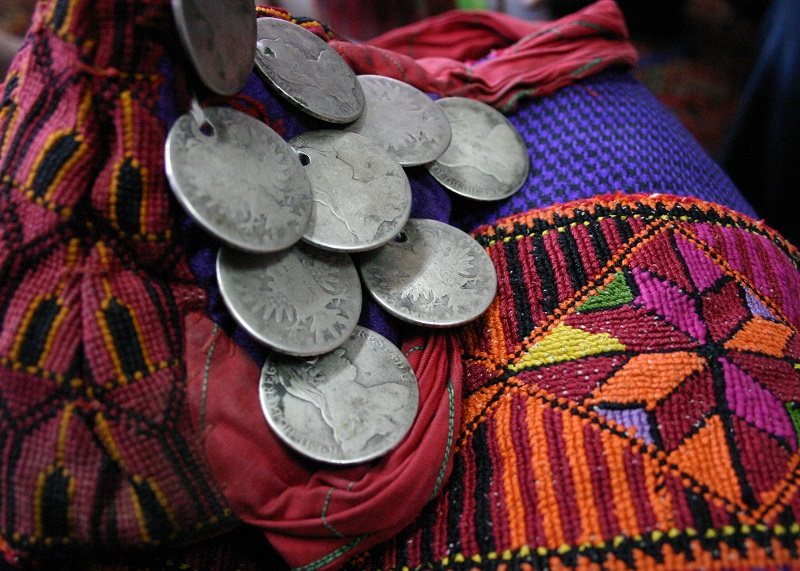 Thalers sewn on the back of a headcover (called ‘araqīye bi-zanbū‘) from the Hebron region, Palestine (wearable heritage collection).
Thalers sewn on the back of a headcover (called ‘araqīye bi-zanbū‘) from the Hebron region, Palestine (wearable heritage collection).Coining an Empress
The Maria Theresa thaler, sometimes shortened to MTT, is without a doubt one of the most famous coins to ever have been minted. Its history is shrouded in a mystery of emotions and sentiments. It was first coined in 1741 with the ascension of Empress Maria Theresa to the Habsburgian throne, of course depicting her bust as was customary for European coins in the 18
th century. The initial attraction of the coin was its very stable silver content and therefore its value.
It was used in the coffee trade with East Africa and Yemen, via Egypt and the Palestinian region. And it was there, in the Middle East, that the popularity of the coin reached its peak. Coffee was increasingly appreciated in Europe in the 18th century and Levantine merchants operating in the trade brought the Thaler with them to the Middle East. The coin became popular very quickly. Soon it could be found in China, Indonesia, Turkey, Yemen and throughout Africa.
However, when the Empress died in 1780 and the Habsburgian Empire changed the image on the coin to that of its new Emperor, it became clear for the first time that there is more to the Maria Theresa thaler than meets the eye. In the coffee trade, merchants now refused to use the new thaler
en masse and the call for a restrike of Maria Theresa’s coin became almost deafening.
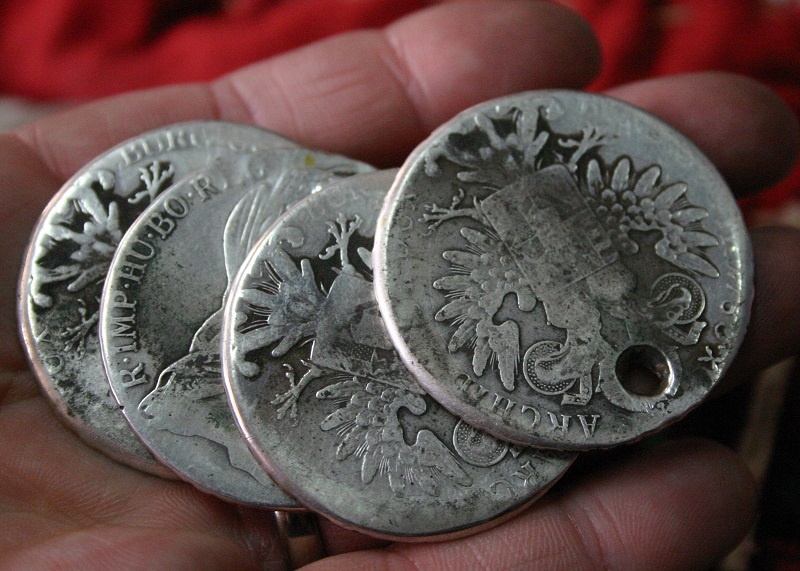 Perforated thalers used in the silver jewellery trade (wearable heritage collection).
Perforated thalers used in the silver jewellery trade (wearable heritage collection).Millions of thalers
Of course, the new Emperor reminted the coin soon after, and the MTT has now been minted for a longer period áfter the death of the Empress than during her lifetime. Since her death the date on the coin has remained unchanged, fixed at 1780. After millions of thalers had been minted and Europe's silver resources were almost exhausted, Mexican silver became the source of the thaler. The coin was not only produced in Austria. In the 19th and 20th century the coin was additionally minted in England, Belgium and even in the Netherlands; countries striving for control and influence in Africa and the Middle East in the First and Second World War. Even though the Austrians did not have African colonies, they did dominate the economy with their beloved currency!
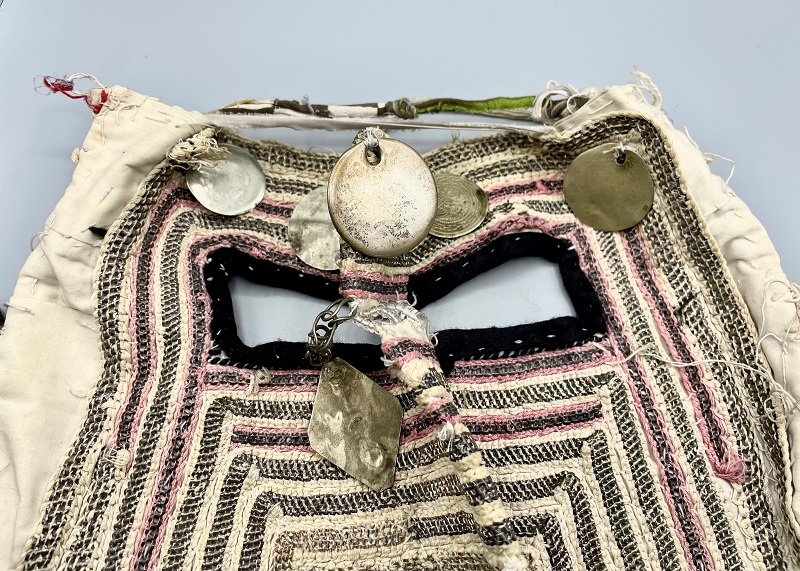 A Rashaidah face veil, decorated on the nose rim with a heavily worn thaler and different coins (wearable heritage collection).
A Rashaidah face veil, decorated on the nose rim with a heavily worn thaler and different coins (wearable heritage collection).Unique source for jewellery
Obviously, the coin had a fixed monetary value in Austria, but the value of the coin varied according to the value of silver in countries where no monetary system existed. Here, the thalers were favoured mostly for their extremely stable silver content. Even though it was easy to import raw silver, the silver of the MTT was often preferred over other silver sources.
Apparently, the value of the silver that once carried the portrait of the Empress was also favoured for its attributed invisible powers. Millions of thalers have been melted down since, and thalers became a primary source of silver in the region. We can safely say that in the majority of Bedouin jewellery that we find in collections today, silver from the thaler can be found to some extent because it was the habit to melt and reforge silver jewellery in an ongoing tradition.
Another widespread use of the MTT is its use as an amulet. One of the main appreciations of the coin lies in its apotropaic powers. The fact that Maria Theresa gave birth to 16 children made the coin a very successful amulet, to promote fertility for example. Women all over the world have also worn thalers as a pendant for repelling evil or as protection. Bells are soldered at the bottom to ward off evil spirits with their sound. The image of the Empress is often carried directly on the skin of the wearer in Islamic countries, with her head hidden away from sight. Whereas Christian women carried the coin with the image of Maria Theresa visible, as a reference to Maria the mother of Jesus. In Christian societies, the coin was therefore also often cut into a cross pendant.
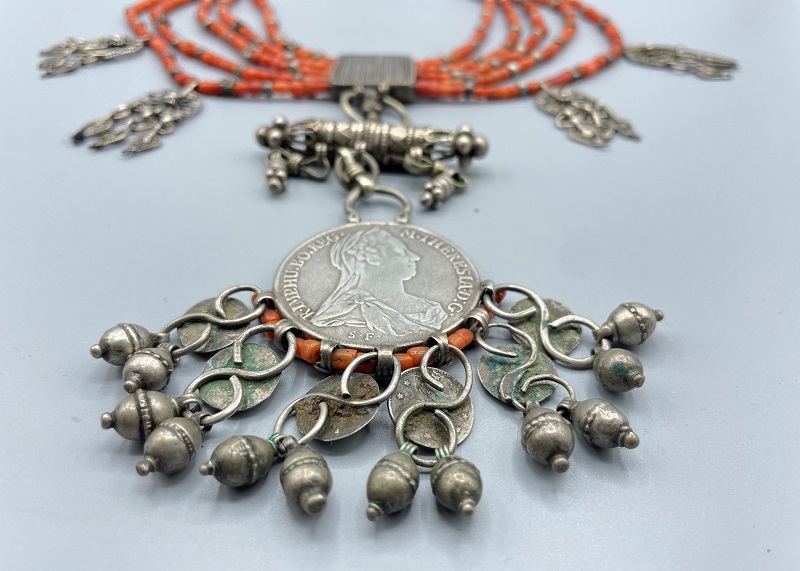 Yemeni silver necklace with thaler and red coral
Coral: (Greek: korallion, probably from Hebrew: goral – small pebbles), is a pale to medium shade of pink with orange or peach undertones, resembling the colour of certain species of coral. beads (wearable heritage collection).
Yemeni silver necklace with thaler and red coral
Coral: (Greek: korallion, probably from Hebrew: goral – small pebbles), is a pale to medium shade of pink with orange or peach undertones, resembling the colour of certain species of coral. beads (wearable heritage collection).Abu Rish
Many countries have tried to strike their own coins with a resemblance to the thaler, but none of these currencies was able to take its place. Why this coin became famous and others did not, remains a matter of taste, a whim of human preference. The Maria Theresa Thaler has received many names in the course of its history of which ‘riyal nimsawi’ (the Austrian riyal) is only one. It was also known as ‘abu rish’ (literally translated as ‘father of the feathers’), referring to the feathers of the depicted eagle on the coin. It was also occasionally called Levantiner, after the merchants from the Levant who mainly traded with them. And it is known as ‘riyal faranchi’ (Frankish riyal) in many countries of the West Asian and North African region.
Nowadays, hundreds of years after the death of Maria Theresa, when you buy an antique piece of silver jewellery on the bazaars of Africa, you should not be surprised to find that the merchant will weigh the silver piece against a stack of MTT’s as counterweights on a scale. This has to do with the stable weight of the coins. Apparently, merchants have had more trust in the thaler than other merchants' weights. And in the process of determining the silver content of silver objects tested with a test-stone, the colour of silver from a thaler is often used as an indicator for the silver value of the other object. In this manner, the thaler has had a huge impact on the economies of Europe and Africa and shows a bizarre lifecycle, involving quite some emotion.
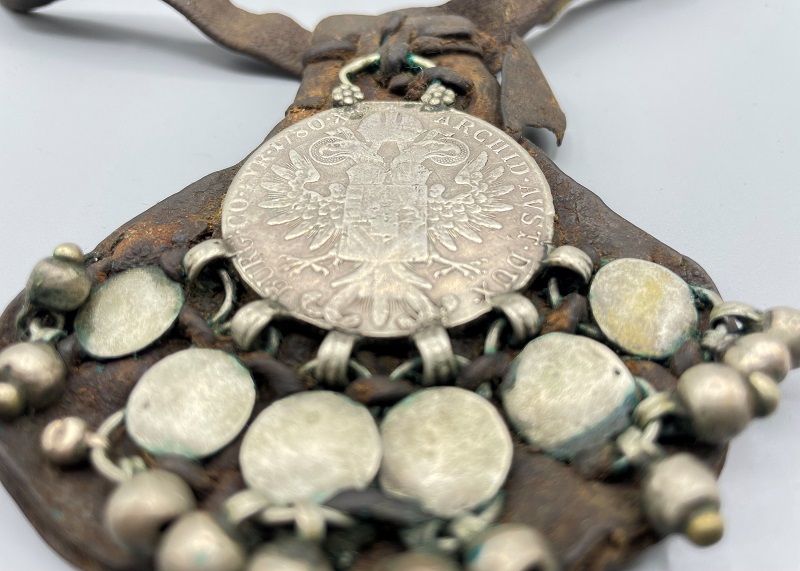 Bedouin forehead ornament (called nunah) from Marib, Yemen (wearable heritage collection).
Bedouin forehead ornament (called nunah) from Marib, Yemen (wearable heritage collection).About the Author
Jolanda Bos is currently writing a book on Maria Theresa thalers in traditional silver jewellery. The book will be published with BLKVLD Publishers in the second half of 2022. For more information, please visit the publisher’s website, Jolanda's
Wearable Heritage website or find them on Instagram or Facebook.
Further reading
*Feature image: Sigrid van Roode




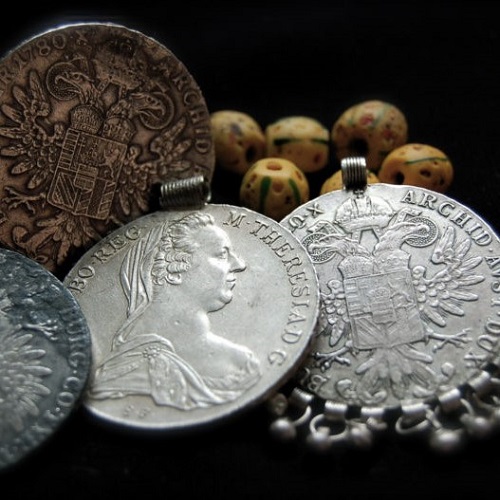
 Thalers sewn on the back of a headcover (called ‘araqīye bi-zanbū‘) from the Hebron region, Palestine (wearable heritage collection).
Thalers sewn on the back of a headcover (called ‘araqīye bi-zanbū‘) from the Hebron region, Palestine (wearable heritage collection). Perforated thalers used in the silver jewellery trade (wearable heritage collection).
Perforated thalers used in the silver jewellery trade (wearable heritage collection). A Rashaidah face veil, decorated on the nose rim with a heavily worn thaler and different coins (wearable heritage collection).
A Rashaidah face veil, decorated on the nose rim with a heavily worn thaler and different coins (wearable heritage collection). Yemeni silver necklace with thaler and red coral
Coral: (Greek: korallion, probably from Hebrew: goral – small pebbles), is a pale to medium shade of pink with orange or peach undertones, resembling the colour of certain species of coral. beads (wearable heritage collection).
Yemeni silver necklace with thaler and red coral
Coral: (Greek: korallion, probably from Hebrew: goral – small pebbles), is a pale to medium shade of pink with orange or peach undertones, resembling the colour of certain species of coral. beads (wearable heritage collection). Bedouin forehead ornament (called nunah) from Marib, Yemen (wearable heritage collection).
Bedouin forehead ornament (called nunah) from Marib, Yemen (wearable heritage collection).